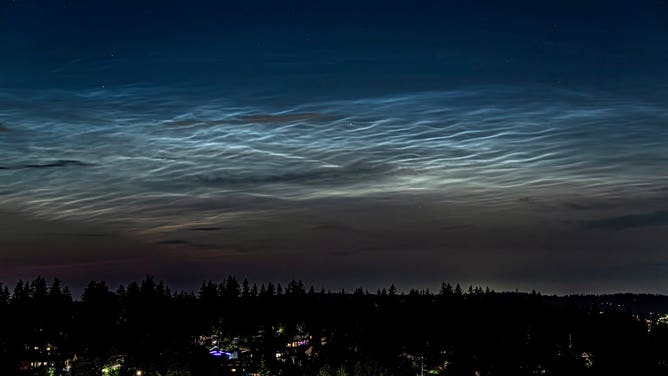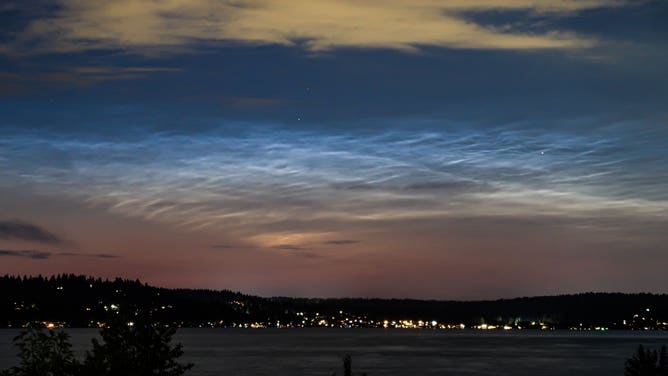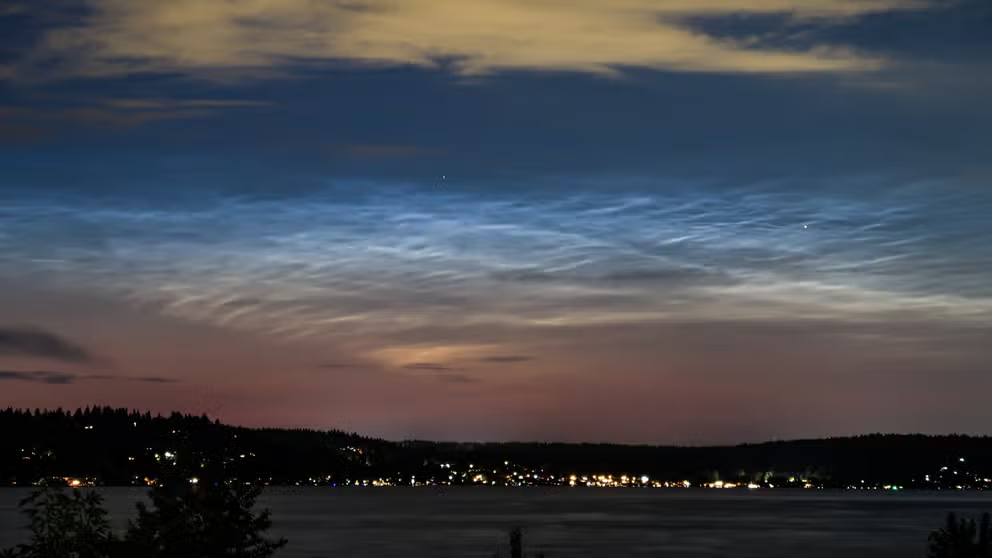Glowing clouds borne from leftover meteor smoke signal summer's arrival
A photographer saw a dazzling display of "Polar Mesospheric Clouds" – informally known as noctilucent clouds, or "night-shining" clouds, which graced the skies just after sunset on Sunday night in Bellevue, Washington.
Glowing noctilucent clouds spotted over Seattle area
Summer is here, and with it comes the chance to be treated to a stunning display of bluish clouds that appear to have luminescence.
Summer is here, and with it comes the chance to be treated to a stunning display of bluish clouds that appear to have luminescence.
Already, these bluish-tinged clouds have made an appearance in the Pacific Northwest. A photographer with EZ Lorenz Photography saw a dazzling display of "Polar Mesospheric Clouds" – informally known as noctilucent clouds, or "night-shining" clouds, which graced the skies just after sunset on Sunday night in Bellevue, Washington, and were there again just before sunrise Monday morning.
HOW ICE CRYSTALS CAN TURN ORDINARY CLOUDS INTO A BRILLIANT DISPLAY OF RAINBOW COLORS
But these clouds do not signal approaching storms or rain; instead, they are in the highest reaches of the atmosphere.

Noctilucent clouds are spotted over Bellevue, Washington, just before sunrise on June 26, 2023.
(EZ Lorenz Imagery / FOX Weather)
"PMCs are water-ice clouds that form about 50 miles above the surface of the Earth, primarily in the summer hemisphere polar region," says Prof. Cora Randall at the University of Colorado. She is also the principal investigator of the NASA Aeronomy of Ice in the Mesosphere Cloud Imaging and Particle Size instrument.
Like regular clouds, noctilucent clouds are formed from condensed water vapor, but instead of dust or other Earth-born particles, these clouds coalesce around leftover meteor smoke.
The resulting ice particles are just 50 nanometers in size – that is 0.000002 inches across.
WHY IS THERE A RAINBOW AROUND THE SUN?
But for this to happen, temperatures must be quite cold – at least -190 degrees Fahrenheit, Randall said. Those temperatures can be found near the poles, some 50 miles high in the mesopause area of our atmosphere.

Noctilucent clouds are spotted over Bellevue, Washington, just after sunset on June 25, 2023.
(EZ Lorenz Imagery / FOX Weather)
"Which is why they somewhat ironically form in the summer," she said. "The polar mesopause in summer is the coldest region on Earth, even colder than the winter polar mesopause."
These clouds form over the poles but spread south. They can appear at night in summer but are best seen in the 30 to 60 minutes just before sunrise or after sunset. June and July are the best months to see them.
They used to be rare sightings and relegated to far northern latitudes. But in recent years, it appears sightings are becoming more frequent and farther south. Recently, those as far south as Los Angeles and Las Vegas have spotted them.
Blue hue is similar to why sunny skies are blue
Part of the beauty of the display is that the clouds seem to give off a glowing blue color, instead of white or gray like traditional clouds.

Noctilucent clouds are spotted over Seattle just after sunset on June 25, 2023.
(National Weather Service, Seattle / NOAA)
"It's because of Rayleigh scattering," Randall said. The ice cloud particles are so tiny that they scatter out the shorter light wavelengths like blue light. Light from the sun well below the horizon will shine through the clouds, with the blue light becoming scattered, and that's the light you'll see reflected back to your eyes.
So, next time you’re out and about on a warm summer evening, and the sun has just set, take a peek at the skies and see if you will be treated to the surreal display of clouds born from meteors.
